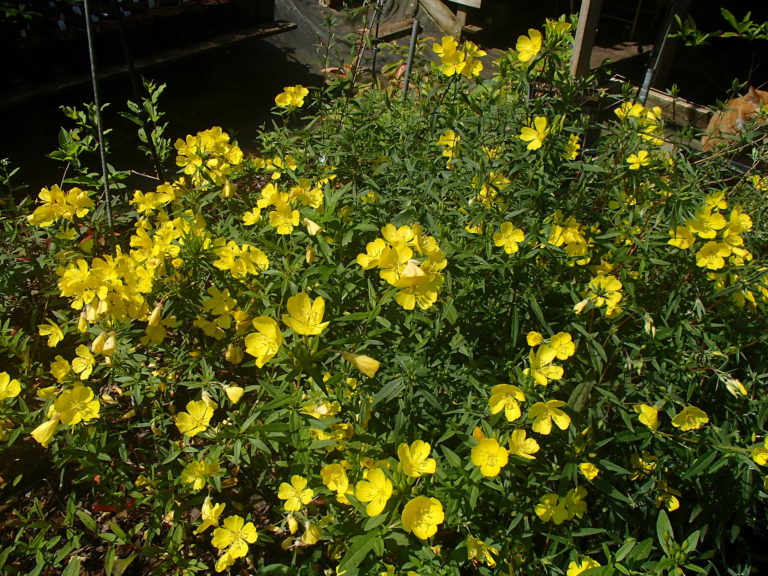Southern Sundrop is a day-flowering perennial (from the Evening Primrose family) native to much of Eastern North America and reported nearly throughout NC. Its habit is upright, (two feet tall x 1.5 feet wide), a little sprawling, with an overwintering evergreen basal rosette. It’s obvious value in the garden is from its numerous 4-petaled, delicate, poppy-like flowers. Bright yellow with orange stamens, the flowers appear in May and June and in our experience will continue sporadically until winter. Individual flowers are short lived, but keep coming for many weeks. It will form colonies by means of rhizomes and would do well on a sunny bank. Grown in full sun to light shade in well drained soil, Southern Sundrop is easy to grow and dependable for our hot climate It attracts birds and hummingbirds and many insect pollinators.
NURSERY HOURS
Wednesday: 10-4 Thursday: 10-6 Friday-Saturday: 10-4 Sunday: 12-4
Oenothera fruticosa

Key Info
Scientific Name: Oenothera fruticosa L.
Common Names: Sundrops, Narrow-Leaf Evening Primrose
Family Names: Onagraceae (Evening Primrose Family)
Plant Type: Herbaceous perennial
Leaf Retention: Deciduous
Flower Color: Bright yellow
Special Characteristics: Tolerates heat, Reported to be deer resistant., Attracts butterflies, Tolerates dry conditions, Attracts Hummingbirds, Attracts birds, Rhizomatous
Additional Info
Habit: Upright or somewhat sprawling and informal, clump-forming habit with multiple slender, pubescent, branched stems; basal rosette reddish in winter; plants form colonies by means of rhizomes.
Height: 18-24"
Spread: 1-2'
Soil Conditions: Well drained, dry, organic; acidic to circumneutral pH; sandy, loamy, clay; prefers light soils
Leaves: Alternate, lance-shaped, 2-3 inches long x 1 inch wide with serrated margins and pointy tip; leaves of evergreen basal rosette are reddish and more oval.
Flowers (or reproductive structures: Red flower buds open to colorful yellow, delicate, 4-petaled blooms with reflexed sepals and orange stamens, 2 inches across, in dense terminal clusters
Fruit: The flowers are followed by distinctive, club-shaped red seed capsules which add to the floral display.
Natural Distribution: Roadsides and disturbed fields, rock outcrops, dry woods, meadows.
USDA Hardiness Zone: 4 to 9
USDA Wetland Indicator Status in NC: FAC (FACU on Coastal Plain)
Pollination: Sphinx moths
Wildlife Connections: Hummingbirds, skippers, beetles, butterflies, honeybees and native bees are attracted to the nectar; caterpillars of several moths feed on the foliage; songbirds consume the seeds (New Moon)
Propagation: By seeds or softwood cuttings; also, stems lying on the soil will root.
